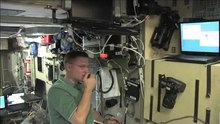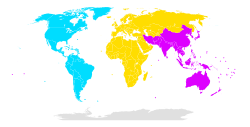ARISS

The project ARISS ( English Amateur Radio on the International Space Station , German: Amateur Radio on the International Space Station ) is an amateur satellite service and allows students radio contact with astronauts in the space station ISS . Radio amateurs who do volunteer work establish connections between schools and the space station.
The first phase of ARISS already took place in the first module of the ISS Sarja , so that the astronaut William Shepherd made the first contact with school during the first ISS mission on December 21, 2000 just two years after its start . The APRS - Digipeater is also located on the Sarja module .
The ARISS International Working Group is located in Silver Spring, MD, United States.
Antennas of the ISS

As part of ARISS phase 2, several antennas for shortwave , VHF , UHF and the L-band were installed on the Zvezda module during various space missions . For the amateur radio station in the Columbus module, antennas for the S and L bands were installed on its micrometeorite protective shield in October 2007 . The originally planned antennas for UHF were not installed for cost reasons. The cost of installing the antennas on the Columbus module exceeded 100,000 euros. The Technical University of Wroclaw applied to the Polish Ministry of Science and Development for a fund that covered 14,000 euros of the costs. Another 69,000 euros were financed by ARISS from donations.
HamTV
On April 13, 2014 the final configuration of HamTV, a DATV system on the Columbus module of the International Space Station ISS, took place. ISS commander Koichi Wakata ( call sign KC5ZTA operating the DATV transmitter in Columbus module under the Belgian rings OR4ISS. The mission of the ARISS antenna 43 was at the bottom of the French amateur radio station F6DZP 2395 MHz in 13-cm amateur radio band received and the video platform YouTube. The HamTV system should deliver not only sound, but also live images from the space station for future school contacts. The first test deployment should take place on September 1, 2014 at the ARISS radio contact with the Siegburg high school in North Rhine-Westphalia. However, on February 11, 2016, during ISS Expedition 46 , the first successful use of HamTV took place during school contact between ISS flight engineer Timothy Peake (callsign KG5BVI) and the Royal Masonic School for Girls from Rickmansworth , Great Britain instead of.
Frequencies
| 2 meter tape | Operating mode | use | ITU region | |
|---|---|---|---|---|
| Downlink | Uplink | |||
| 145.800 MHz | 145.200 MHz | Fonie in FM | Crew contact | Region 1 |
| 145.800 MHz | 144.490 MHz | Fonie in FM | Crew contact | Region 2 and 3 |
| 145.800 MHz | SSTV in FM | SSTV downlink of an outboard camera | worldwide | |
| 145.825 MHz | 145.825 MHz | FM with 1200 baud AFSK | APRS - digipeater | worldwide |
| 2 meter tape / 70 centimeter tape | Operating mode | use | ITU region | |
| Downlink | Uplink | |||
| 145.800 MHz | 437.800 MHz | Fonie in FM | Cross-band repeater | worldwide |
| 437.800 MHz | 145.990 MHz | Fonie in FM with 67 Hz CTCSS | Cross-band repeater | worldwide |
| 2 meter tape / 23 centimeter tape | Operating mode | use | ITU region | |
| Downlink | Uplink | |||
| 145.800 MHz | 1269.650 MHz | Fonie in FM | Cross-band repeater | worldwide |
| 70 centimeter tape | Operating mode | use | ITU region | |
| Downlink | Uplink | |||
| 437.550 MHz | 437.550 MHz | Fonie in FM | Crew contact Simplex | worldwide |
| 13 centimeter tape | Operating mode | use | ITU region | |
| Downlink | Uplink | |||
| 2.395 GHz | DATV symbol rate : 2.0 MS / s | HamTV | worldwide | |
Web links
- Official international website
- Official European website
- APRS amateur radio stations digipeated by the ISS
- Current status of the station
- Status of HamTV
- ARISS school contacts from ESA astronaut Dr. Alexander Gerst to listen to
Individual evidence
- ↑ a b c ARISS antennas installed on Cokumbus. October 20, 2007, accessed January 8, 2013 .
- ↑ International Space Station Ham Radio (also known as Amateur Radio on the International Space Station (ARISS))
- ↑ KC5ZTA in the Federal Communications Commission (FCC) database )
- ↑ HamTV test
- ↑ ARISS contact planned with Gymnasium Siegburg, Germany. Retrieved April 1, 2019 .
- ↑ KG5BVI in the Federal Communications Commission (FCC) database
- ↑ Gaston Bertels, ON4WF: HamTV on the ISS. HamTV School Contact - A World First! ARISS, accessed on March 14, 2017 (English).


